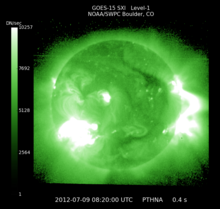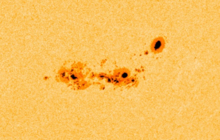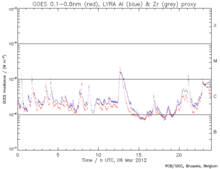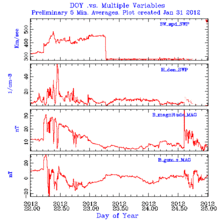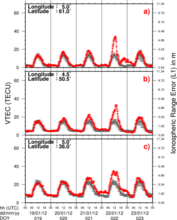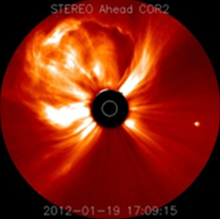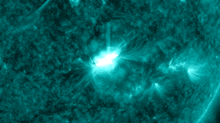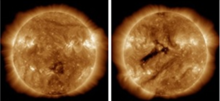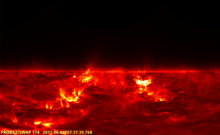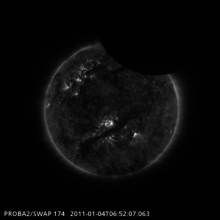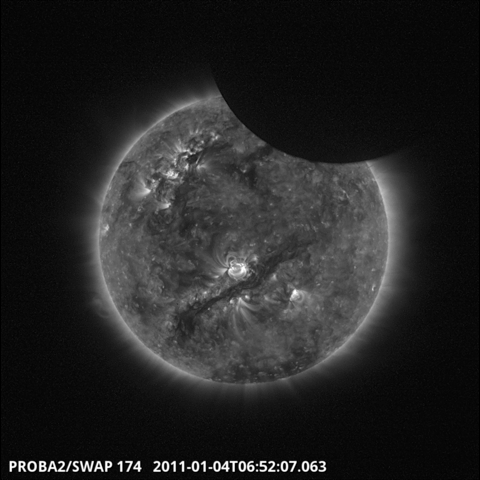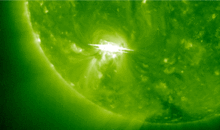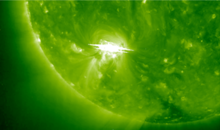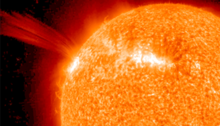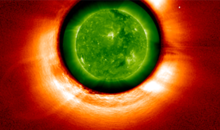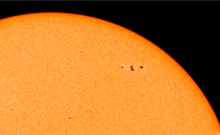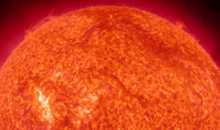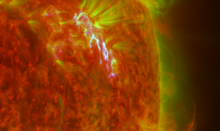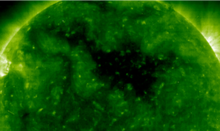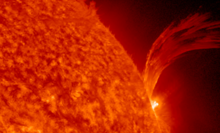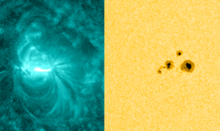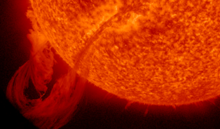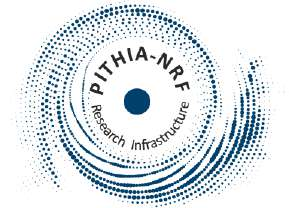news
Submitted on 2012-07-10As noted in a previous comment, NOAA 1515 produced 5 high energetic events during its transit. The last of these events was an M6.9-flare on July 8th that occurred while NOAA 1515 was already close to the western solar limb. The flare started at 16:23UT and reached its maximum x-ray intensity at 16:32UT. The images underneath show the eruption as seen by PROBA2/SWAP and in H-alpha during the flare's peak and at 16:54UT. One can clearly see that material is ejected from the blast site.
Submitted on 2012-07-06NOAA 1515 appeared at the southeastern solar limb on June 27th. With a maximum sunspot area of only about 5 times the total surface of the Earth, it certainly did not become the biggest sunspot group so far this solar cycle.
Nonetheless, the group was quite complex and showed interesting dynamics. For example, the images underneath taken by SDO/HMI on 1 and 2 July show the splitting of the main spot in less than 24 hours! Cytokinesis of solar proportions!

Submitted on 2012-03-22According to http://www.swpc.noaa.gov, the GOES-15 data provision is temporarily interrupted.
PROBA2 LYRA has set-up an alternative for the GOES flare monitoring service using the zirconium channel of the PROBA2/LYRA radiometer (proba2.sidc.be) as a GOES proxy. It is especially useful when GOES is unavailable, as happened on March 21, 22 and 23. See http://solwww.oma.be/users/dammasch/GoesVsLyra.html.
Submitted on 2012-01-31
The GNSS research group of the Solar-Terrestrial Centre of Excellence measured ionospheric disturbances on Jan 22 which impact the communication and satellite navigation at that moment.
Submitted on 2012-01-23The Sun has again an activity revival since Jan 16, not an extra ordinary revival, but high. No records were broken. There was a series of plasma ejections, not straight to Earth, but glancing blows from above. The most dangerous aspect up to now is the ongoing proton event.
For aurora-watchers: the chance for aurora in Belgium is very small.
Submitted on 2011-12-31A compilation of the most memorable space weather moments of 2011 can be found underneath. Using the fantastic (J)Helioviewer software, a ***MOVIE*** was created containing one or more clips of each event.
Submitted on 2011-09-06Solar Activity
The Sun is shifting to an even higher activity level compared to the previous month. The higher values of the International Sunspot Number and the 10cm flux translated into a series of events: a sequel of Earth-directed CME's and flares, the up to now strongest flare of the current cycle and a proton event.
Submitted on 2011-06-09On June 07, 2011, there was a spectacular plasma eruption on the Sun. The shock ahead of the plasma cloud skimmed Earth on June 09, 20:00UT. We give a chronological order of how the Space Weather Forecast Centre of Belgium handled the event.
|
June 07, 08:00UT - 10:00BLT |
Submitted on 2010-12-31A compilation of the most memorable space weather moments of 2010 can be found underneath. Using the fantastic (J)Helioviewer software, a ***MOVIE*** was created containing one or more clips of each event.
Pages
Zircon - This is a contributing Drupal Theme
Design by
WeebPal.

